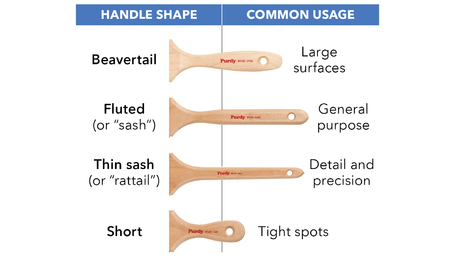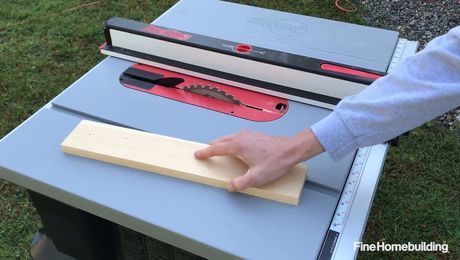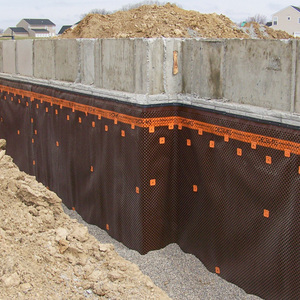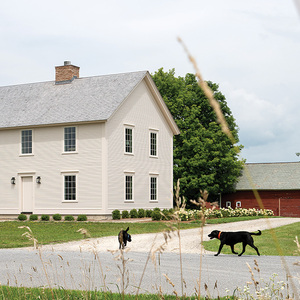*
I’ve decided that I better buy myself a 1/2″ drill so that I don’t burn out my 3/8″ drill. I’m interested in using it for a broad range of applications. Would it be advisable for me to pay a bit more and buy a right angle drill for electrical/plumbing applications. (Drilling holes between studs and joists) Are there any things that a right angle drill does better besides this? Are there any things that a regular drill does better than a right angle drill? Does anyone have any models to suggest? Thank you very much.
Discussion Forum
Discussion Forum
Up Next
Video Shorts
Featured Story

Tips for picking the right paintbrush based on paint type, surface, and personal comfort.
Featured Video
SawStop's Portable Tablesaw is Bigger and Better Than BeforeHighlights
"I have learned so much thanks to the searchable articles on the FHB website. I can confidently say that I expect to be a life-long subscriber." - M.K.
Fine Homebuilding Magazine
- Home Group
- Antique Trader
- Arts & Crafts Homes
- Bank Note Reporter
- Cabin Life
- Cuisine at Home
- Fine Gardening
- Fine Woodworking
- Green Building Advisor
- Garden Gate
- Horticulture
- Keep Craft Alive
- Log Home Living
- Military Trader/Vehicles
- Numismatic News
- Numismaster
- Old Cars Weekly
- Old House Journal
- Period Homes
- Popular Woodworking
- Script
- ShopNotes
- Sports Collectors Digest
- Threads
- Timber Home Living
- Traditional Building
- Woodsmith
- World Coin News
- Writer's Digest


















Replies
*
Between members is the only time I ever needed a right angle, but if you're doing a big hole, you really need it. If you get the big Milwaukee right angle, it is just a half inch with a right angle adapter and it easily converts back to a straight drill.
*I've got a 1/2" Milwaukee Magnum that I wouldn't trade up for anything. It's the most balls out drill that I've ever used in my life. Lonecat does bring up a good point with the Milwaukee right angle drill - it's a great drill, but it's a nasty wrist breaker at the same time. Whichever route you go for a corded drill, make sure it's red. Good luck - Nick
*Have you thought about the Milwaukee 1/2 in. close quarter drill as a sort of compromise? Like all of the big red stuff, it's heavy and can wring your arm off.
*I've got a 1/2" Milwaukee Magnum and wouldn't trade it for anything else. It's the most balls out drill that I've ever used. Lonecat brings up a good point about the Milwaukee right angle drill - it's a great tool, but it can be a really quick route to a broken wrist if you're not careful. In any case, if you're gonna buy a corded drill, make sure that it's red. Good luck - Nick
*Now why didn't that post the first time. Hmmmm, the computer is playing some tricks on me tonight.
*I've got the 'Hawg and a Dewalt 1/2" pistol grip. They both have their place and I don't want to give up either one. The 1/2 magnum that Ace has is nice; I bought one, but the trigger didn't fit my hand so well. The 'Hawg is great for what it's intended for- plumbing and electrical in stud bays and such- but it's cumbersome for other stuff and I usually reach for my Dewalt 1/2" or Makita 3/8" (in the case of the 3/8", usually a cordless)Sam
*I've had a pc 1/2 pistol style drill for 15 years. It's a decent all around tool.But my new hole hawg (right angle) kicks ass.blue
*Think about RPM too, depends how you use it. My Milwaukee RA drill (not quite the Hawg, the one that looks like a sawzall with a chuck -- $220 at the big box -- see <a href=http://www.amazon.com/exec/obidos/ASIN/B0000223HJ/qid=959032906/sr=1-1/103-8217439-5099006>amazon.com's listing?) runs at about 350 RPM and has torque galore. I use it for a lot of things where a regular inline drill would work too, like holes for ledger bolts, and think it's a little easier for feeding a ship auger bit in plumb and level. For big hole work every day, you'd want a Hawg ($300?).Spade and twist bits work better at high speed; my DeWalt 1/2" is over 2000 RPM and spade bits work SO much better than in the old 1300 RPM (brand unmentionable) drill.Seems like you have pretty clear brand recommendations!.
*I have had a Milwaukee Plumber's kit for many years with no problems. If it still comes in a metal case, there is room for holw saws, arbors, and extensions as well as the drill itself. I like the versitility of the right angle as it gets into tight corners as well as providing additional leverage for the torque that these units generate. As of late, I have also used it to mix setting type drywall compound with good results. Hope this helps.Dennis
*I have had a Milwaukee Plumber's kit for many years with no problems. If it still comes in a metal case, there is room for hole saws, arbors, and extensions as well as the drill itself. I like the versitility of the right angle as it gets into tight corners as well as providing additional leverage for the torque that these units generate. As of late, I have also used it to mix setting type drywall compound with good results. Hope this helps.Dennis
*If you are drilling studs and joists regularly, then you need both drills. If not, a pistol grip fits between 16" centers and for tightfighterters, you can buy a $20 dollar right angle adapter for infrequent use. Having said that, I have a Milwaukee Close Quarter drill and I borrow a friend's Milwaukee D-Han-Handlet Angle drill for big jobs. I have 9 other corded drills, including the big Milwaukee ½" 450 rpm wrist ramter. Aduster.mmer drill. And 3 12v cordless drills. Each one has a use and I would not give up any of them.
* A few years ago I was asking myself that same question, I had heard that Milwaukee was tops in 1/2" right angle drills, so prior to purchasing one I also got good feedback on the Porter Cable 7556 VSR and checked out the specs. The PC has an 8 amp motor 0 to 330 and 0 to 750 rpm reversing and more torque, better than the Milwaukee and at a lower price! An excellent tool at a reasonable price. Also it is very good at mixing those 5 gallon pails of joint compound. Check the specs and gearing and feedback.
*I feel a good choice would be a D-handle Milwaukee 1/2" drill and then buy the right angle attachment separately. Not real cost effective and the back and forth conversion is a little tedious but this way you have both types of drills and one motor. I have one like this and we also have a Hole Hawg that could probably drill through a mountain if you can hold on tight enough.
*
I've decided that I better buy myself a 1/2" drill so that I don't burn out my 3/8" drill. I'm interested in using it for a broad range of applications. Would it be advisable for me to pay a bit more and buy a right angle drill for electrical/plumbing applications. (Drilling holes between studs and joists) Are there any things that a right angle drill does better besides this? Are there any things that a regular drill does better than a right angle drill? Does anyone have any models to suggest? Thank you very much.